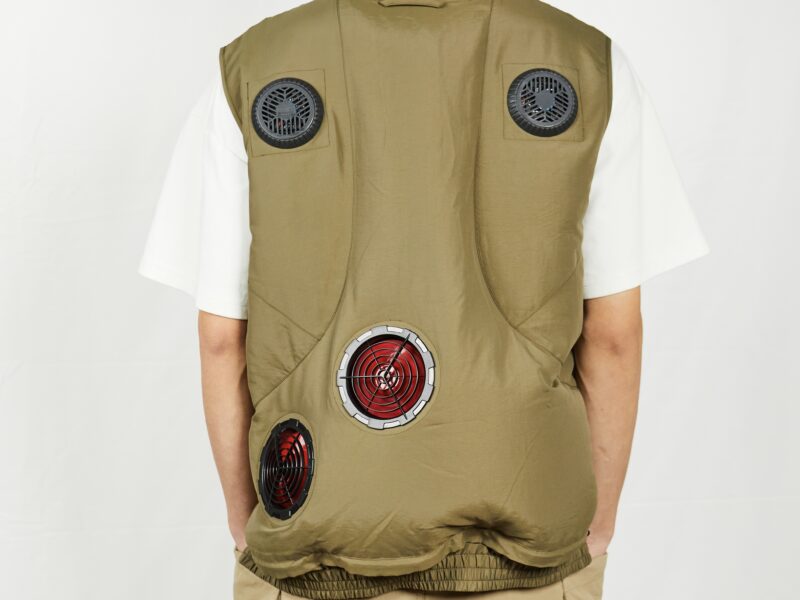
✅ Working Principle of Peltier Effect-Based Wearable Cooling
The Peltier Effect: The Core of Semiconductor Cooling
Semiconductor cooling chips, also known as TEC chips (Thermoelectric Coolers), work based on the Peltier effect. This physical principle appears when an electric current flows through the junction of two different types of conductors or semiconductors.
When current passes through a TEC chip, it absorbs heat on one side while releasing it on the other side. By managing the heat transfer efficiently, the “cold end” can produce a rapid cooling effect within seconds.
How TEC Chips Are Integrated into Wearable Devices
A wearable semiconductor cooling vest or jacket typically uses multiple integrated layers:
- Skin-contact layer: Made of soft, breathable, skin-friendly fabric that is durable and comfortable.
- TEC module layer: A lightweight array of P/N-type thermoelectric pairs packaged together.
- Heat dissipation module: An active fan or graphite sheet helps transfer heat away from the hot side, keeping the cold side stable.
- Intelligent electronic control: Manages current flow, regulates temperature, and ensures safe operation.
- Power supply system: Usually powered by a 5V or 12V mobile power bank through USB-C.
Key Advantages of Peltier-Based Wearable Cooling
Compared to traditional compressor-based systems, semiconductor cooling offers unique benefits:
- No moving parts: No compressors, no noise, and no vibration.
- Chemical-free: No refrigerants, making it eco-friendly and safe.
- Compact and lightweight: Perfect for wearable integration.
- Fast cooling: Delivers a noticeable cooling effect within 3–5 seconds after power-on.
- Flexible design: The latest TEC chips use laminated, flexible packaging. This makes them ideal for vests, jackets, insoles, or other smart wearables with adjustable temperature control.
Application Scenarios
Peltier effect-based cooling vests and apparel are suitable for:
- High-temperature work: Construction, warehousing, transportation.
- Outdoor activities: Cycling, fishing, camping, hiking.
- Medical cooling: Fever relief or recovery support.
- High-intensity tasks: Military, law enforcement, or athletes exposed to heat.
- Future development: Integrated flexible batteries and smart control systems for better user experience.
Current Challenges and Development Directions
Although semiconductor cooling has many advantages, it still faces some challenges:
- Heat dissipation efficiency: Effective removal of heat from the hot end is essential to keep the cold end working well.
- Flexibility: Ongoing research aims to develop flexible thermoelectric materials that can adapt to body movement and close-fit clothing.
- Power optimization: Improving energy efficiency will help reduce battery burden and extend runtime.
- Weight balance: Maintaining comfort while integrating the cooling modules.
✅ Summary
Applying semiconductor cooling technology to wearable devices is shaping the future of personal climate control. By leveraging the Peltier effect, wearable cooling solutions deliver portable, quiet, and environmentally friendly cooling without traditional compressors or refrigerants. This innovative technology continues to evolve toward flexible, battery-integrated, smart wearables that offer precise, adjustable cooling whenever and wherever you need it.mass production, and has shown great potential in the fields of smart wear, sports health, and extreme environment work.
If you’d like to learn more about our wearable cooling solutions, custom OEM modules, or partnership opportunities, please contact us at info@yubinglobal.com. We’re here to help you stay cool and productive.

Recent Comments